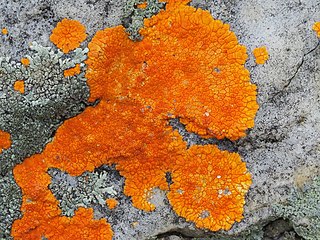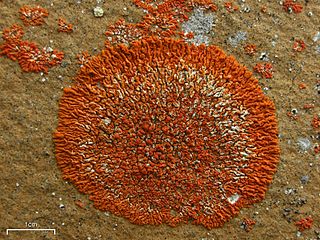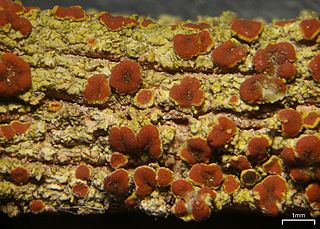
The Physciaceae are a family of mostly lichen-forming fungi belonging to the class Lecanoromycetes in the division Ascomycota. A 2016 estimate placed 19 genera and 601 species in the family.
Sirenophila is a genus of crustose lichens in the subfamily Teloschistoideae of the family Teloschistaceae. It has four species with an Australasian distribution.
Filsoniana is a genus of squamulose lichens in the family Teloschistaceae. It has six species. It was circumscribed in 2013 by Ingvar Kärnefelt, Arne Thell, Jae-Seoun Hur, Sergey Kondratyuk, and John Elix following a molecular phylogenetic analysis of the Teloschistaceae. The generic name honours Australian lichenologist Rex Filson, "in recognition of his contribution to lichenology, in particular to the lichen flora of Australia".
Huneckia is a genus of crustose lichens in the subfamily Caloplacoideae of the family Teloschistaceae. It has four species.

Neobrownliella is a genus of crustose lichens in the subfamily Teloschistoideae of the family Teloschistaceae. It has five species. The genus was circumscribed in 2015 by lichenologists Sergey Kondratyuk, Jack Elix, Ingvar Kärnefelt, and Arne Thell, with Neobrownliella brownlieae assigned as the type species. It is a segregate of the large genus Caloplaca. Characteristics of Neobrownliella include a thallus that is continuous or areolate, the presence of anthraquinones as lichen products, a cortical layer with a palisade paraplectenchyma, and the lack of a thick palisade cortical layer on the underside of the thalline exciple. Two species were included in the original circumscription of the genus; an additional three species were added in 2020.

Rusavskia is a genus of lichen-forming fungi in the family Teloschistaceae. It has 12 species. It is a member of the subfamily Xanthorioideae. The thallus of Rusavskia is characterized by its foliose (leaf-like) structure with distinct and typically narrow lobes that curve outwards.

Opeltia is a genus of lichen-forming fungi in the family Teloschistaceae. It has four species of corticolous (bark-dwelling), crustose lichens.

Erichansenia is a genus of lichen-forming fungi in the family Teloschistaceae. It has three species of saxicolous (rock-dwelling), crustose lichens.
Fauriea is a genus of lichen-forming fungi in the family Teloschistaceae. The genus, which contains seven species, is a member of the subfamily Caloplacoideae.
Marchantiana is a genus of lichen-forming fungi in the family Teloschistaceae. It contains seven species of corticolous (bark-dwelling), crustose lichens that occur in the Southern Hemisphere.
Verrucoplaca is a monotypic fungal genus in the family Teloschistaceae. It contains the single species Verrucoplaca verruculifera, a widely distributed saxicolous (rock-dwelling), crustose lichen that grows on coastal rocks.
Eilifdahlia is a genus of lichen-forming fungi in the family Teloschistaceae. It contains three species of corticolous (bark-dwelling), crustose lichens that occur in the Southern Hemisphere.
Hosseusiella is a genus of lichen-forming fungi in the family Teloschistaceae. It has three species of crustose to foliose (leafy) lichens, some of which grow on bark, while others grow on rock. All three occur in the southern part of the South American continent, where they are fairly common.
Franwilsia is a genus of lichen-forming fungi in the family Teloschistaceae. It has three species.
Sirenophila cliffwetmorei is a species of saxicolous (rock-dwelling), crustose lichen in the family Teloschistaceae. It is found in Australia. Its thallus can reach up to 1 centimetre in width, has a whitish to whitish-grey colour, and is very thin, sometimes almost merging with the substrate, and has paler edges with a darker grey centre. Its numerous tiny apothecia give the thallus a yellow-orange appearance.
Oxneriopsis is a genus of lichen-forming fungi in the family Teloschistaceae. It has four species of corticolous (bark-dwelling), crustose lichens.
Elixjohnia jackelixii is a species of saxicolous (rock-dwelling), crustose lichen in the family Teloschistaceae. It is found in Australia and New Zealand. The lichen is characterised by its unique multilayered appearance with outer sterile rings that are brownish or greenish-yellow and inner areoles that are whitish, yellowish, or greyish, often cracked to reveal the medulla underneath. Its fruiting bodies, or apothecia, are typically attached directly to the thallus and vary in colour and shape.
Yoshimuria is a genus of lichen-forming fungi in the family Teloschistaceae. It has four species of crustose lichens.

Coppinsiella is a genus of lichen-forming fungi in the family Teloschistaceae. It contains five species of corticolous and saxicolous crustose lichens with a distribution in Europe, Asia, and North America. Coppinsiella bears resemblance to the genus Athallia, but it is distinguished by its more developed thallus, typically featuring distinctive crater-like soralia and zeorine-form apothecia, which lack a thalline margin.
Marchantiana occidentalis is a species of corticolous and saxicolous, crustose lichen in the family Teloschistaceae. It is found in Western Australia, usually as an inhabitant of dry twigs, bark, or wood of various plant species, but occasionally on granite rock outcrops. It forms a well-developed thallus, shiny and composed of tiny dark greenish to brown areoles, with sizes typically ranging from 5–15 mm, though larger aggregations are possible. It features numerous rounded apothecia scattered across its surface, varying in form and colour, with a distinct margin and disc.





